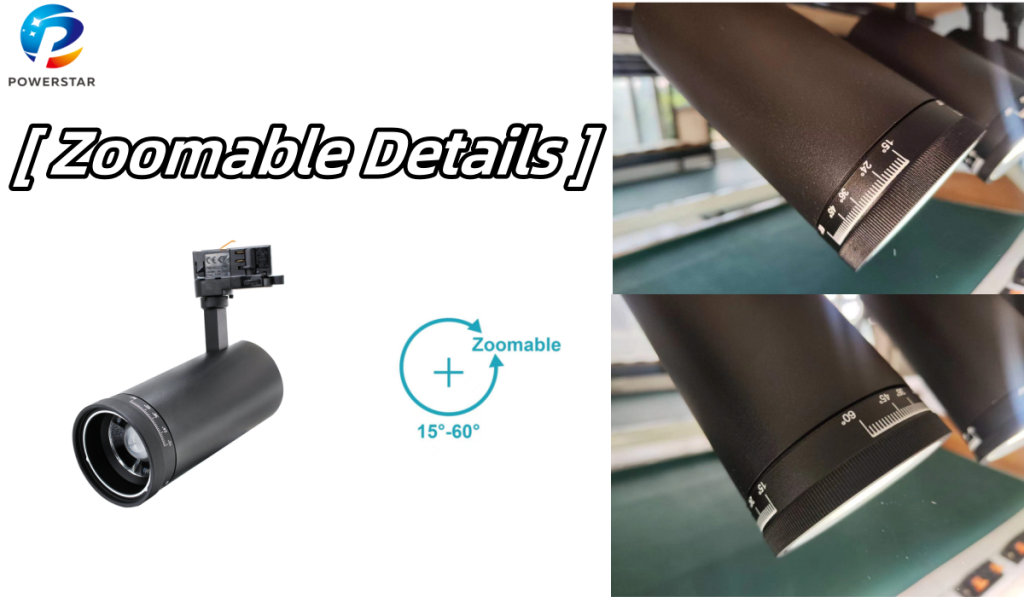Focusing zoomable Track Lights: Innovative Solutions for Flexible Lighting
By Powerstar

Flexibility and functionality are becoming core requirements in contemporary focusing lighting design.
Whether it is a commercial space, home environment or art exhibition, precise lighting control can significantly enhance the atmosphere and practicality of the scene. As a lighting tool with both technical and artistic values, focus track light has become a popular choice in modern lighting field with its unique focusable function. In this article, we will analyze the core functions, applicable scenes and advantages of focus track lighting.
What is a focusing track light?
Zoomable track light is a kind of adjustable light installed on the track system, its core feature is to support the “optical zoom” function. By manually or electrically adjusting the distance between the light source and the lens, users can freely change the angle of the light beam (e.g. from 15° to 60°), thus controlling the irradiation range and dispersion effect of the light. Compared with traditional fixed angle track lights, the zoom design gives the light a stronger dynamic adaptability.
The core function of focusing track lights
Flexible adjustment of lighting range: This flexibility avoids the hassle of frequent luminaire changes and is particularly suitable for locations where dynamic layout adjustments are required. The focus function allows the user to adjust the beam angle at any time as required:
Narrow beam (15°-30°): Focused illumination of small areas such as exhibits, decorative paintings or table tops ;
Wide beam (45°-60°): covers large spaces and provides uniform base lighting.

Precise light control to minimize waste:
By focusing the light, a dimmable track light concentrates the light energy on the target area, reducing the energy loss caused by scattering. In museums, for example, a narrow beam of light can illuminate artifacts precisely without affecting the surrounding environment, protecting exhibits and reducing energy consumption.
Multi-scene Adaptation Capability:
The same track system can be installed with luminaires of different angles at the same time, or quickly switch modes through focusing to meet diversified needs. For example, window lighting in a clothing store can use wide light to create a sense of transparency during the day, and switch to spotlight at night to highlight the main products.
Artistic light and shadow design:
Designers can utilize the focusing function to create layered light and shadow effects, such as wall washes, accent lighting, or gradient transitions, to enhance the aesthetics of the space.
Typical application scenarios for focusing track lights
Commercial space:
Retail Stores: Highlight merchandising areas or promotional booths by adjusting the angle of the beam;
Dining Venue: Narrow light focuses on the table, wide light creates overall ambiance.
Art gallery/ showroom: Precise control of exhibit lighting to avoid UV damage.
Office and public space:
Meeting rooms: focus on the podium during presentations, switch to uniform lighting during discussions;
Library: partition lighting taking into account the reading area and bookshelf guide.
Advantages of focusing track light
Economical and efficient;
One light can be used for multiple purposes, reducing the cost of purchasing and maintenance of lamps and lanterns;
Energy-saving design can reduce long-term electricity expenses.
The track system supports modularization expansion, no need to rewire for increasing, decreasing or moving the lamps at a later stage.
Convenient installation
The track system supports modularization expansion, no need to rewire for increasing, decreasing or moving the lamps at a later stage.
Professional Lighting Efficiency
High color rendering index (CRI ≥ 90) to restore the true color, with the focusing function to meet the needs of professional lighting.


